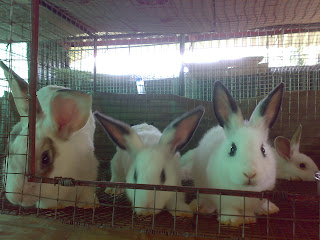The picture below is called Doe #3 and her first litter. She is one of the 3 replacement does that we kept from the first litter of my original stock of Cinnamon breed. Since we bred the original Cinnamon doe to the Chinchilla buck, so this makes her a half Cinnamon and half Chinchilla mix. We bred all 3 replacement does on Februay 04, 2012 but only two of her siblings, Doe #1 and Doe #2 got pregnant whereas this Doe #3 did not take.
Have you ever tried to palpate a rabbit for pregnancy check just to see if there are babies that formed inside her? Well I haven't done this myself for fear that I may be doing more harm than good just in case I make a mistake in palpating the doe. I have read about this subject on the Internet but I do not have the nerve to try it on my rabbits. If the doe does not get pregnant the first time, then perhaps she will the next time we try to have her mated again. The recommended age before the doe can be bred is at 6 months old. She was born on August 18, 2011 so she was already 5 1/2 months old when I first attempted to mate her with the Chinchilla buck on February 04, 2012. Unfortunately, she did not get pregnant.
So on April 09, 2012, I decided to have her mated with the New Zealand buck. We counted 28 days after she was mated and then we put in the nest box and some cut-up newspapers inside the cage. Gestation period takes 30-31 days before she delivers her first litter so she has two days to fix her nest. Once she feels that she is ready to make her nest, she would gather the cut up newspapers in her mouth and bring these to her nest. She will be busy jumping in and out of her nest box but just let her arrange her nest the way she wants it done. You will notice, too, that she will pull some fur from her dewlap and fill the nest box with these. This will help ensure that her kits will be warm once she delivers. They usually kindle at night or early in the morning. Finally, on May 09, 2012, she delivered 8 healthy kits. We removed the nest box 15 days after the kits were born, this is to prevent the kits from getting any disease from the litter in the nest box. We sometimes leave the nest box much longer than the recommended 15 days especially if the weather is cold. Since it is summer when they were born, and they were already leaving their nest box more often, so we took off the nest box and we just left a piece of cardboard on the floor for them to sleep on.
 |
| Doe #3 and her 1st litter |















%5B1%5D.JPG)

































